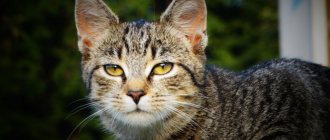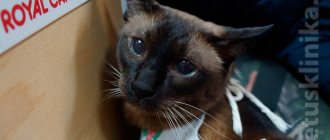Diabetes mellitus in cats is a common and fairly common endocrine disease; in this disease, the animal’s body is not able to properly monitor the amount of glucose in the blood and its metabolism. At the same time, insulin production decreases or tissue cells become resistant to its action. And partial or complete insulin deficiency is the cause of persistent hyperglycemia, which characterizes feline diabetes mellitus.
In general, a cat is a different animal from a dog and is more sensitive to stress, which can cause blood glucose levels to rise, although this does not mean that the cat necessarily has diabetes, but only temporary hyperglycemia. When the cat calms down, this phenomenon goes away. Therefore, sometimes when taking blood in a clinic, where every pet can be very worried, sugar may turn out to be elevated, and such a case always requires further clarification.
What is diabetes mellitus?
Diabetes mellitus is a condition in which there are high levels of sugar (glucose) in the blood. Insulin is produced in the pancreas and is the hormone responsible for maintaining proper blood glucose levels. Therefore, high blood glucose levels are caused by decreased insulin production and/or the body not responding properly to the insulin produced.
Approximately 1 in 200 cats suffers from diabetes. Cats commonly develop type 2 diabetes. The disease is caused by a combination of the body's inadequate response to insulin and the depletion of the cells that produce insulin. Due to a lack of insulin, the body's cells cannot use the sugar (glucose) needed to produce energy.
Insulin therapy
To treat diabetes in cats, insulin is prescribed to help control blood glucose levels throughout the day. Animal-based insulin is better suited for cats - bovine or pork (Caninsulin).
Synthetic human insulin is absorbed less well and is excreted faster, for example, it lasts not 24 hours, but 12. Among drugs of this type, Levemir and Lantus have shown good results.
How to treat diabetes in cats: injections or tablets
The tablets stimulate the pancreas, improving insulin synthesis, so they are not very effective if the gland is not working (in type 1 pathology). In addition, frequent use of pills can aggravate the condition of the pancreas and damage the liver.
Insulin injections do not give such a reaction. The hormone immediately enters the bloodstream, bypassing the pancreas, causing less damage to the liver. For this reason, doctors recommend insulin injections.
Importance of dosage
Before treating diabetes mellitus in a cat, it is necessary to correctly set the dose of insulin. The difficulty is that when an animal visits a doctor, its blood sugar rises due to stress. Therefore, the dose is prescribed based on measurements taken by the owner at home. If the cat owner is unable to do the test during the day, the dosage is prescribed based on the level of fructosamine in the blood.
In most cats, positive dynamics begin a few days after taking insulin. The recommended dose is 1-2 injections per day.
The importance of monitoring your pet's condition
A sick cat should have its blood and urine glucose levels measured daily. Keep in mind that different brands of insulin affect cats differently. Some medications may last less, while others may last longer.
Monitoring blood glucose levels will help adjust the dose, depending on the type of insulin and the health of the cat. The data obtained during the measurements must be recorded in a diary. It must indicate:
- insulin injection time;
- medication dosage;
- blood and urine sugar levels;
- quantity and time of feeding;
- volume of liquid drunk;
- cat's weight (once a week).
The veterinarian will need this data in order to adjust the treatment regimen in time. You cannot change the dosage yourself if the cat feels better or worse. Moreover, it is forbidden to stop taking insulin without your doctor’s instructions.
Insulin overdose: consequences
If you give your cat too much insulin, his blood glucose levels may drop to critical levels (hypoglycemia). Symptoms:
- weakness and lethargy;
- shiver;
- staggering (drunk gait);
- convulsions;
- loss of consciousness;
- vomit;
- loss of bladder control.
Hypoglycemia is a deadly condition that requires urgent medical attention. To revive your cat while you wait for the doctor, rub honey on her gums.
Glucose in a cat with diabetes
Cats develop diabetes when they do not respond adequately to insulin and/or the pancreas does not produce enough insulin. This means that glucose cannot leave the blood, enter the body's cells and be used as the main source of energy. The cat's body begins to break down muscle and fat as alternative sources of energy. This causes the cat to eat more, but its body weight decreases. At the same time, blood glucose levels rise because it is unable to leave the bloodstream and enter the body's cells.
Common symptoms found in cats
- Increased thirst
- Frequent urination
- Increased feed intake
- Weight loss
- Marked lethargy
- Weakness
If left untreated, diabetes can lead to serious metabolic problems (diabetic ketoacidosis), which can lead to coma or death.
What increases your risk of diabetes?
There are two main factors that increase your risk of diabetes: a high-carbohydrate diet and lack of physical activity.
Wrong diet. Cats are obligate carnivores. Their body is designed in such a way that it receives everything it needs for health from an appropriate diet. What do predators eat? They eat prey, fresh meat.
Their bodies cannot produce certain amino acids, such as taurine. Cats get it strictly from food. Taurine is found in meat. There are other amino acids and vitamins that they need that are found in abundance in fresh meat.
Cereals are a source of carbohydrates. Large amounts of carbohydrates lead to obesity and diabetes. Feeding a diabetic a high-carbohydrate diet will only make the condition worse. Preservatives and other artificial ingredients increase stress on the liver
Insufficient physical activity. When a cat is sedentary, she does not burn the same amount of calories as she does from high-carbohydrate foods.
Cats have a peculiarity: their body breaks down proteins in order to control blood sugar levels. The organism of creatures is not adapted to process carbohydrates into energy. Carbohydrates that the body cannot process into energy are converted into fats. Fats are deposited in the body, and the pet gains weight.
Why is high blood glucose a problem?
When blood glucose levels are high, glucose levels in the urine will also increase. This leads to increased urine production and, as a result, increased thirst in the animal. Long-term high blood glucose levels (glucose toxicity) can damage pancreatic cells, which can lead to decreased insulin production. Very high blood glucose levels can lead to serious complications such as diabetic ketoacidosis (DKA), a condition that occurs when a cat's body needs to break down fat as an energy source. Cats with high blood glucose levels over a long period of time can be susceptible to damage to other parts of the body, such as the eyes, nerves, and kidneys.
What to do at home
The owner is required to follow the specialist’s instructions and provide the sick pet with the best possible care. Diabetes is not a death sentence. Even if it is impossible to cure it, it is quite possible to prolong the life of a four-legged pet.
The owner will have to constantly monitor the sugar in the furry’s blood and urine. Most cat owners use special test strips to determine sugar.
Seeing the result, the owner can make the necessary adjustments to the diet and take appropriate measures to reduce this dangerous indicator. Glucometers give more accurate results; as a rule, they are used in severe stages of the disease.
The cat's nutrition is of great importance. The diet is compiled individually. The specialist takes into account the cat’s general condition and sugar levels. The diet must contain protein and fiber. Carbohydrates are allowed, but should not be abused! Meals are fractional, but no more than 6 times.
With this treatment regimen, the pancreas experiences minimal stress, glucose is maintained at an optimal level throughout the day. A specialist, as a rule, recommends certain medicinal feeds for use. The owner needs to understand that a sick pet will have to stick to this diet for the rest of its life.
How is diabetes diagnosed?
All signs of diabetes can also be found in other diseases, so your veterinarian will need to do more than just examining your cat. To diagnose diabetes, your veterinarian will need to perform blood tests and often a urine test. Cats with diabetes show several changes:
- High blood glucose levels
- High blood fructosamine levels (a marker that indicates blood glucose levels over the previous 2 weeks)
- Glucose in urine
Your veterinarian may also perform some other blood tests to check if there are any underlying conditions that may affect the treatment plan.
Treatment control
To achieve an improvement in the animal’s well-being, you need to regularly monitor the treatment process:
- Monitoring urine and blood tests. These indicators will help the veterinarian adjust the dosage of drugs.
- A good practice is to keep an observation diary, where the owner enters data about the insulin used. The diary must record information about the time of administration and dose of insulin, the amount of food and water consumed, and changes in the pet’s weight.
- Monitoring urine sugar levels at home. You can check the amount of sugar in your urine using test strips that are sold at pharmacies. The required amount of sugar in the urine should be zero, that is, the urine should not contain glucose.
- Monitoring blood sugar. The normal amount of sugar in pets is 6 mmol per liter. You can use a glucometer to perform this test. It is also possible to monitor blood sugar levels using test strips.
How to collect a urine test from a cat
Why is a urine test needed to determine the disease? With its help, you can adjust the dose of insulin and check the effectiveness of the drug on the body. Many cat owners are perplexed about how to collect a urine test from their pets. For the test to be correct, a morning or night dose of urine is suitable. Here are some tips:
- It is convenient to collect urine when the pet goes into a tray without sand, with a grid that will help in this matter.
- It is also proposed in this case to use not sand in the tray, but sterilized gravel that does not absorb moisture. Urine will run through it to the bottom of the tray. All that remains is to collect it in a container.
- In extreme cases, in a clinical setting it is possible to collect urine using a catheter. It is often not recommended to use this method, because it can injure the animal’s ureter.
How to take a blood sugar test correctly
A cat suffering from diabetes needs to have blood taken daily for insulin. This is a very important procedure, since the animal may experience stress at this moment, and therefore insulin will not show the correct results. When treatment has just begun, to find out whether insulin is having the proper effect on the body, a blood test will have to be taken every 1.5 hours. The quality of the analysis is affected by the time and amount of food eaten.
- It is best to take a blood test from the ear, in the middle of which there is a vessel from which it is easy to take a test.
- The blood test should be carried out only using disposable needles, which are included in the kit with the glucometer.
- The glucometer handle with the needle should be placed on the outside of the ear above the vessel. The blood test should be taken only from a warm and dry ear; you can pre-warm it with a dry palm.
- When droplets of blood appear, you need to bring the glucometer with the plate. The blood will be absorbed into the plate.
A cat taking insulin should not feel hungry.
How to treat diabetes?
Although diabetes is a serious condition that often cannot be cured, in most diabetic cats the condition can be successfully controlled with insulin, often in combination with dietary changes. This will reduce high blood glucose levels and allow the body's cells to use glucose as their main source of energy. The overall goal of treatment is to control the clinical signs of diabetes and ensure a good quality of life for the cat.
Treatment method and prognosis
Treatment for type 1 and type 2 diabetes will differ. In the first case, insulin therapy (short-acting drugs) is performed. If the disease develops in the second type, the veterinarian prescribes long-acting or intermediate-acting insulin, or replaces hormones with drugs that help lower blood sugar and increase glucose levels.
Compliance with the dosage is the key to successful treatment. Drugs that lower blood sugar have a lot of side effects.
Insulin is used in the form of injections, which is associated with certain difficulties. Calculating the optimal dose is quite difficult. Measurements are carried out in a veterinary clinic. It will take from 18 hours to 24 hours to establish the glucose level after the administration of an insulin drug.
Next, the veterinarian calculates the time, duration and strength of the hormonal drug. The information obtained helps to correctly draw up an individual scheme according to which the cat will have to receive insulin.
As for the prognosis, for diabetes it is cautious or unfavorable (for the first type)
Ensuring your cat's well-being
For most cats, stabilization can be achieved very easily with lifelong therapy and related measures. You should work with your veterinarian to determine the best insulin dose, ideal diet, and lifestyle adjustments (if necessary) to achieve maximum control. Make sure you give your cat the correct dose of insulin on schedule. Maintain a regular feeding schedule and offer your pet the amount of food recommended by your veterinarian. Do not give your cat medications, including vitamins or nutritional supplements, without first consulting your veterinarian.
What you need to know about the disease
Feline diabetes is a disease similar to humans. It has similar causes and clinical picture.
Why diabetes is dangerous
Without timely treatment, the disease leads to sudden weight loss, dehydration, problems with motor function, coma and death. The danger of the pathology is that it is detected late. By the time cats are diagnosed, they are usually already severely insulin dependent.
Risk group
Animals suffering from obesity and inflammation of the pancreas are at particular risk. There is no clearly defined age category for cats with diabetes. Although it has been noted that most often the disease occurs in middle-aged and elderly pets. The disease is more common in cats than in cats.
What is the outlook for my diabetic cat?
The long-term outlook for cats with diabetes varies depending on their age, how easy it is to stabilize their diabetes, whether they have any other medical conditions, and how severe they are. Most cats with diabetes have an excellent quality of life, and many can live very comfortably with diabetes if the disease is properly controlled. Unfortunately, not every cat responds well to therapy. Your veterinarian will need regular exams to evaluate your cat's response to treatment, and if your cat's condition is difficult to stabilize, becomes unstable, or appears to require very large doses of insulin, additional tests may be needed to look for other underlying conditions. If you are concerned about your cat's condition, take her to a veterinarian.
How to prevent diabetes in animals?
Diabetes mellitus in cats cannot always be prevented, but the risk of the disease can be reduced. To do this, you need to follow a few simple recommendations.
A healthy diet is the key to the health and long life of your predator. Wild cats do not suffer from diabetes because they eat fresh meat and the internal organs of their victims. Their diet contains no carbohydrates or artificial ingredients. Harmful substances do not accumulate in the body, food is well absorbed, so they do not suffer from the same ailments that pets suffer from. Natural, biologically appropriate nutrition will help reduce the risk of diabetes.
Play and a cat-friendly environment can help provide physical activity Play with your pet regularly. Leave toys she can play with while she's home alone. Equip your home with a cat tree so your pet can climb and jump. If possible and if she shows interest in the street, take her for a walk on a harness.
Regular checkups with a veterinarian will help detect not only diabetes, but also other health problems, if any. Once a year, have your pet's blood tested to make sure all organs are working as they should.
A healthy diet and an active lifestyle are key to your cat's health.
Signs
Diagnosis in cats can be somewhat difficult. Unlike dogs, they are characterized by a stressful increase in glucose levels at a doctor's appointment, in addition, symptoms so typical of diabetes (increased thirst, frequent urination) also appear in feline chronic renal failure and hyperthyroidism.
Symptoms of diabetes in cats:
- obesity;
- polydipsia (increased thirst);
- polyuria (increased volume of urine excreted);
- poor appetite;
- weight loss;
- atrophy of the spinal muscles;
- weakness of the pelvic limbs (when walking, the cat relies on the hock joints);
- oily, shiny coat, dandruff;
- yellowness of mucous membranes;
- hepatomegaly (enlarged liver);
- lethargy, apathy, lethargy.
Diabetic ketoacidosis is a serious disorder of the acid-base balance of the blood caused by the breakdown of liver proteins and lipids. Typical symptoms: depression, lethargy, vomiting. A transition to a coma is possible. It is a life-threatening condition. Therapy is possible only in a hospital setting.
Symptoms of the disease in cats
The most rapidly developing diabetes is insulin-dependent. This is due to the lack of insulin production and replacement. There are no primary symptoms, so cat owners pay attention to the disease when it leads to significant disruptions in the functioning of the animal’s body.
Characteristic symptoms:
- thirst, the amount of liquid drunk increases 2-3 times;
- frequent urination;
- dryness, itching of mucous membranes and skin;
- general weakness;
- decreased vision.
In insulin-dependent diabetes, the functioning of the gastrointestinal tract is disrupted, nausea, vomiting, and diarrhea occur. Convulsive states periodically appear, the cat may have a specific smell.
Excessive appetite and an increase in the volume of food eaten are another sign of diabetes, while the animal loses weight and has a sickly, unkempt appearance.
Severe itching forces the cat to scratch the itchy areas, and wounds appear that do not heal for a long time. When a secondary infection (bacteria) attaches, they become covered with pus, and the pathological process spreads to healthy tissue, increasing the area of damage.









